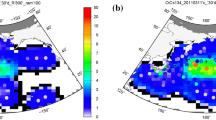Abstract
Based on the statistics of all surface drifting buoys of 1978–2011 and Lagrangian tracers simulated from high quality ocean reanalysis currents, the impact times and strength of Fukushima nuclear pollution to the east coast of China and the west coast of America have been estimated. Under the circumstances of the radioactive pollutants drifting in the ocean surface, preliminary research results show that while the tracers took about 4 years to reach the west coast of USA, there are two types of tracers to carry out Fukushima nuclear pollutants to reach the east coast of China, corresponding to 1.5-year recirculation gyre transport and 3.5-year subtropical circulation transport. The distributions of the impact strength at these time scales are given according to the variation of relative number concentration with time combined with the decaying rate of radioactive matter. For example, starting from 1% at 1.5-year, of the initial level at the originating area of Fukushima nuclear pollution, the impact strength of Cesium-137 in the South China Sea continuously increases up to 3% by 4 years, while the impact strength of Cesium-137 in the west coast of America is as high as 4% due to the role of strong Kuroshio-extension currents as a major transport mechanism of nuclear pollutants for that area.
Similar content being viewed by others
References
Liu A H, Kuai L P. A review on radionuclides atmospheric dispersion modes. J Meteorol Environ, 2011, 27: 59–65
Shimizu Y, Yasuda I, Ito S I. Distribution and circulation of the coastal Oyaishio intrusion. J Phys Oceanogr, 2001, 31: 1561–1578
Han G J, Li W, Zhang X F, et al. A regional ocean reanalysis system for coastal waters of China and adjacent seas. Adv Atmos Sci, 2011, 28: 682–690
Marshall J, Hill C, Perelman L, et al. Hydrostatic, quasi-hydrostatic and nonhydrostatic ocean modeling. J Geophys Res, 1997, 102: 5733–5752
Li W, Xie Y, He Z J, et al. Application of the multi-grid data assimilation scheme to the China Seas’ temperature forecast. J Atmos Ocean Technol, 2008, 25: 2106–2116
Li W, Xie Y, Deng S M, et al. Application of the multigrid method to the two-dimensional doppler radar radial velocity data assimilation. J Atmos Ocean Technol, 2010, 27: 319–332
Xie Y, Koch S, Mcginley J, et al. A space-time multiscale analysis system: a sequential variational analysis approach. Mon Weather Rev, 2011, 139: 1224–1240
Carton J A, Chepurin G, Cao X. A simple ocean data assimilation analysis of the global upper ocean 1950–95. part I: Methodology. J Phys Oceanogr, 2000, 30: 294–309
Carton J A, Chepurin G, Cao X. A simple ocean data assimilation analysis of the global upper ocean 1950–95. part II: Results. J Phys Oceanogr, 2000, 30: 311–326
Author information
Authors and Affiliations
Corresponding author
Rights and permissions
About this article
Cite this article
Han, G., Li, W., Fu, H. et al. An ensemble estimation of impact times and strength of Fukushima nuclear pollution to the east coast of China and the west coast of America. Sci. China Earth Sci. 56, 1447–1451 (2013). https://doi.org/10.1007/s11430-012-4520-2
Received:
Accepted:
Published:
Issue Date:
DOI: https://doi.org/10.1007/s11430-012-4520-2



